Parodia is a genus of flowering plants in the family Cactaceae, native to the eastern slopes of the Andes in northwestern Argentina and southwestern Bolivia and in the lowland pampas regions of northeastern Argentina, southern Brazil, eastern Paraguay, and Uruguay.[1] This genus has about 65 species, many of which have been transferred from Eriocactus, Notocactus and Wigginsia. They range from small globose plants to 1 m (3 ft) tall columnar cacti. All are deeply ribbed and spiny, with single flowers at or near the crown. Some species produce offsets at the base. They are popular in cultivation, but must be grown indoors where temperatures fall below 10 °C (50 °F).[2]
| Parodia | |
|---|---|
 | |
| Parodia magnifica, Huntington Desert Garden | |
| Scientific classification | |
| Kingdom: | Plantae |
| Clade: | Tracheophytes |
| Clade: | Angiosperms |
| Clade: | Eudicots |
| Order: | Caryophyllales |
| Family: | Cactaceae |
| Subfamily: | Cactoideae |
| Tribe: | Notocacteae |
| Genus: | Parodia Speg. |
| Type species | |
| Parodia microsperma | |
Taxonomy and Systematics
The first description was published in 1923 by the Italian-Argentinian botanist Carlos Luis Spegazzini.[3] The genus is named after Domingo Parodi, one of the early investigators of the flora of Paraguay.[4] The type species is Echinocactus microspermus. Anatomical and morphological work by David Richard Hunt et. al.[5] and Reto Nyffeler[6] led to the incorporation of the genera Brasilicactus, Brasiliparodia, Eriocactus, Notocactus and Wigginsia into the genus Parodia. These studies also suggested the inclusion of the genera Blossfeldia and Frailea.
According to Reto Nyffeler, the genus Parodia can be divided into three subgenera:
- Subgenus Parodia:
- Group Parodia: (Parodia s. str.)
The shoots are flat spherical, globular or columnar and rarely sprout. A tuber is rarely present. The shoot tissue usually contains no mucilage, the epidermis is usually tender. The areoles are always on the protuberances. The central and radial spines differ significantly from each other. The central spine is sometimes hooked. The flowers are funnel-shaped, styles and stigmas are always the same color. The soft fruits later dry up and open at their base. - Group Notocactus: (Notocactus s.str. + Wigginsia)
The shoots are flat spherical, globular or columnar and occasionally sprout. A tuber is sometimes present. The shoot tissue usually contains mucus, the epidermis is often hard. The areoles are located in the depressions between the bumps. The central and radial spines differ. The flowers are broadly funnel-shaped to bell-shaped, styles and stigmas are usually differently colored. The fruits, which are often elongated when ripe, open differently.
- Group Parodia: (Parodia s. str.)
- Subgenus Eriocactus:
The shoots are often long columnar in old age and occasionally sprout. The shoot apex is often crooked. The instinctual tissue contains no mucus. The humps are fused into straight ribs. The areoles are located between the protuberances. They are not sunken or only vaguely sunken and are often heavily woolly. The thorns are more or less bristle-like. The light to dark yellow flowers are broadly bell-shaped, styles and stigmas are the same color. The fruits have a hard pericarp and open at the base.
- Subgenus Brasilicactus:
The shoots are flat spherical to rarely short columnar. The shoot apex is often crooked. The remarkably soft shoot tissue contains no mucus. The protuberances are separated from each other and arranged in oblique rows or fused into ridges. The round areoles are close together. Central spines are not formed or are occasionally hooked. There are numerous radial spines. They are narrow, funnel-shaped, styles and stigmas are colored the same. The fruits have a thin pericarp and open at their base.
Species
Species of the genus Parodia according to Plants of the World Online As of January 2023[update] separated into sections according to Reto Nyffeler:[7]
| Subgenus | Section | Image | Scientific name | Distribution |
|---|---|---|---|---|
| Parodia | Parodia |  | Parodia aureicentra Backeb. | Argentina (Salta) |
 | Parodia ayopayana Cárdenas | Bolivia. | ||
 | Parodia chrysacanthion (K.Schum.) Backeb. | Argentina (Jujuy) | ||
 | Parodia columnaris Cárdenas | Bolivia. | ||
 | Parodia comarapana Cárdenas | Bolivia. | ||
 | Parodia diersiana Jucker | Bolivia. | ||
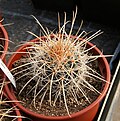 | Parodia commutans F.Ritter | Bolivia | ||
 | Parodia formosa F.Ritter | Bolivia | ||
| Parodia gibbulosoides F.H.Brandt | Bolivia. | |||
 | Parodia hausteiniana Rausch | Bolivia | ||
| Parodia hegeri Diers, Krahn & Beckert | Bolivia | |||
| Parodia horrida F.H.Brandt | Argentina (Salta) | |||
| Parodia larapuntensis Diers & Jucker | Bolivia (Chuquisaca) | |||
 | Parodia maassii (Heese) A.Berger | Bolivia to Argentina (Jujuy) | ||
| Parodia mairanana Cárdenas | Bolivia (Santa Cruz). | |||
 | Parodia microsperma (F.A.C.Weber) Speg. | Bolivia to NW. Argentina | ||
 | Parodia nivosa Backeb. | Argentina (Salta) | ||
 | Parodia ocampoi Cárdenas | Bolivia | ||
| Parodia otaviana Cárdenas | Bolivia. | |||
| Parodia prestoensis F.H.Brandt | Bolivia. | |||
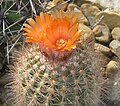 | Parodia procera F.Ritter | Bolivia | ||
 | Parodia ritteri Buining | Bolivia. | ||
 | Parodia schwebsiana (Werderm.) Backeb. | Bolivia | ||
 | Parodia stuemeri (Werderm.) Backeb. | Argentina (Jujuy, Salta) | ||
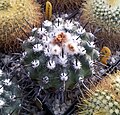 | Parodia subterranea F.Ritter | Bolivia | ||
 | Parodia taratensis Cárdenas | Bolivia | ||
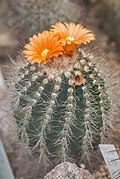 | Parodia tuberculata Cárdenas | Bolivia. | ||
| Notocactus |  | Parodia allosiphon (Marchesi) N.P.Taylor | Brazil (Rio Grande do Sul) to Uruguay | |
 | Parodia buiningii (Buxb.) N.P.Taylor | Brazil (Rio Grande do Sul) to Uruguay | ||
| Parodia calvescens (N.Gerloff & A.D.Nilson) Anceschi & Magli | Brazil (Rio Grande do Sul) to Argentina (Corrientes) | |||
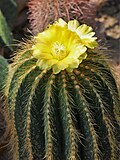 | Parodia claviceps (F.Ritter) F.H.Brandt | Brazil (Rio Grande do Sul) to Argentina (Misiones). | ||
 | Parodia carambeiensis (Buining & Brederoo) Hofacker | Brazil (Paraná) | ||
 | Parodia concinna (Monv.) N.P.Taylor | Brazil (Rio Grande do Sul) to Uruguay | ||
 | Parodia crassigibba (F.Ritter) N.P.Taylor | Brazil (Rio Grande do Sul) | ||
 | Parodia curvispina (F.Ritter) D.R.Hunt | Brazil (Rio Grande do Sul) | ||
| Parodia erinaceus (Haw.) N.P.Taylor | Central Colombia, Brazil (Rio Grande do Sul) to NE. & S. Central Argentina | |||
 | Parodia × erubescens (Osten) D.R.Hunt (P. mammulosa x P. concinna) | Uruguay | ||
 | Parodia fusca (F.Ritter) Hofacker & P.J.Braun | S. Brazil. | ||
| Parodia gaucha M.Machado & Larocca | Brazil (Rio Grande do Sul). | |||
 | Parodia herteri (Werderm.) N.P.Taylor | Brazil (Rio Grande do Sul) to Uruguay. | ||
 | Parodia horstii (F.Ritter) N.P.Taylor | Brazil (Rio Grande do Sul). | ||
| Parodia ibicuiensis (Prestlé) Anceschi & Magli | Brazil (Rio Grande do Sul ). | |||
| Parodia langsdorfii (Lehm.) D.R.Hunt | S. Brazil. | |||
 | Parodia linkii (Lehm.) R.Kiesling | S. Brazil to NE. Argentina | ||
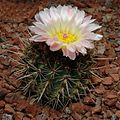 | Parodia mammulosa (Lem.) N.P.Taylor | Brazil (Rio Grande do Sul) to Argentina | ||
 | Parodia mueller-melchersii (Frič ex Backeb.) N.P.Taylor | Brazil (Rio Grande do Sul) to Uruguay | ||
| Parodia muricata (Link & Otto ex Pfeiff.) Hofacker | S. Brazil. | |||
| Parodia neoarechavaletae (Havlíček) D.R.Hunt | Uruguay. | |||
| Parodia neobuenekeri (F.Ritter) Anceschi & Magli | Brazil. | |||
 | Parodia neohorstii N.P.Taylor | Brazil (Rio Grande do Sul) | ||
| Parodia nothorauschii D.R.Hunt | Uruguay | |||
 | Parodia ottonis (Lehm.) N.P.Taylor | S. Brazil to NE. Argentina. | ||
 | Parodia oxycostata (Buining & Brederoo) Hofacker | Brazil (Rio Grande do Sul). | ||
| Parodia roseolutea (Vliet) Hofacker, A.S.Oliveira & R.Pontes | Uruguay. | |||
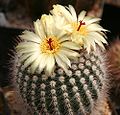 | Parodia scopa (Spreng.) N.P.Taylor | Brazil (Rio Grande do Sul) to Uruguay | ||
 | Parodia stockingeri (Prestlé) Hofacker & P.J.Braun | Brazil (Rio Grande do Sul). | ||
 | Parodia tenuicylindrica (F.Ritter) D.R.Hunt | Brazil (Rio Grande do Sul) | ||
| Parodia werdermanniana (Herter) N.P.Taylor | Brazil (Rio Grande do Sul) to Uruguay | |||
| Eriocactus (Buxb.) F.H.Brandt |  | Parodia leninghausii (F.Haage) F.H.Brandt ex Eggli & Hofacker | Brazil (Rio Grande do Sul) | |
 | Parodia magnifica (F.Ritter) F.H.Brandt | Brazil (Rio Grande do Sul) | ||
| Parodia nigrispina (K.Schum.) F.H.Brandt | Paraguay | |||
 | Parodia schumanniana (Nicolai) F.H.Brandt | Brazil (Rio Grande do Sul) to Argentina (Misiones) | ||
 | Parodia warasii (F.Ritter) F.H.Brandt | Brazil (Rio Grande do Sul) | ||
| Brasilicactus (Buxb.) F.H.Brandt |  | Parodia alacriportana Backeb. & Voll | Brazil | |
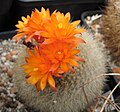 | Parodia haselbergii (Haage ex Rümpler) F.H.Brandt | Brazil (Rio Grande do Sul) | ||
 | Parodia rechensis (Buining) F.H.Brandt | Brazil (Rio Grande do Sul) |
Synonyms
References
Bibliography
- Anderson, Edward F. (2001). The Cactus Family. Pentland, Oregon: Timber Press. ISBN 978-0-88192-498-5.
- Innes, Clive (1995). "Cacti". In Innes, Clive & Wall, Bill (eds.). Cacti, Succulents and Bromeliads. London: Cassell for the Royal Horticultural Society. pp. 11–70. ISBN 978-0-304-32076-9.
 Media related to Parodia at Wikimedia Commons
Media related to Parodia at Wikimedia Commons
